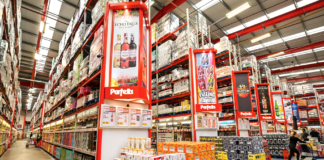Is the cash & carry finished? It is time to think inside the box, argues David Gilroy
The small car park is rammed with vans. The sales floor is piled high with cases of drinks and groceries discounted to destruction. Customers are tearing into the displays and piling their trolleys high. The checkouts are a riot of goods being unloaded, scanned and repacked. Management have their sleeves rolled up, and are in constant dialogue with their customers. Payment at the cash point window is in wads of money. Welcome to cash & carry circa 1991.
This high-octane marketplace was my first experience of wholesale; I was fresh from multiple retail and, for me, this was at once shocking and invigorating.
How has the cash & carry changed?
What has changed since then? Just about everything. The convenience retail and hospitality landscapes have been reshaped by the internet, mobile devices and the recent rapid consolidation of the wholesale sector.
The latest research from consultant Him identifies the increased trend in delivered wholesale at the expense of cash & carry (walk-in).
This is not new. The industry has been going in this direction for nearly 20 years, although this drift is now rapidly accelerating due to changes in the economy, technology and purchasing behaviour. Him’s research points to cash & carries becoming more like ‘top-up’ destinations.
That said, what is there not to love about cash & carries? They offer the opportunity to paint on a big canvas; truckloads, massive bulk, high volume and pallet displays – this is big-scale trading. They bestrode the earth unchallenged for decades but now appear to be under threat. Is this the beginning of the end for cash & carries?
It does not have to be. The challenge for operators is how to migrate from the traditional cash & carry model to the ‘multicentre’ format where walk-in custom can operate alongside the distribution process. This is tricky for cash & carry operators. Years ago, they offered a few customers a delivered option as an added-value service.
Now it is often the main event and pricing it in such a way that it is both commercially acceptable and profitable is devilishly difficult.
For most operators, the delivery business – with all the added costs of picking, vehicles, drivers and credit – is not as profitable as a walk-in facility. This makes a vibrant cash & carry an important part of the business model.
This is a brilliant opportunity for wholesalers, and it is time to think inside the box.
Cash & carries can be highly engaging, tactile and supremely efficient. The shopping experience should be adventurous, with fresh categories and ranges, impulse triggers, new services, and business advice with the opportunity for profit-enhancing ideas and interacting with like-minded customers.
Click & collect
The big opportunity is click & collect. This is the way to offer a 21st-century service experience at an affordable cost. A number of wholesalers are driving this hard as a super-fast alternative to delivery.
The big win for the operators is the opportunity to upsell, the lower cost to serve, the reduced risk of stock loss– on deliveries – and the reduced exposure to late payment and bad debt.
Cash & carries can flourish by getting the basics right – availability, range choice, merchandising, product presentation and speed of service – and then overlaying with things that are new, exciting and adventurous.
All these attributes are difficult to replicate for multiples and tech giants, and will help insulate against market share incursion.
David Gilroy is the co-founder and managing director of Store Excel







